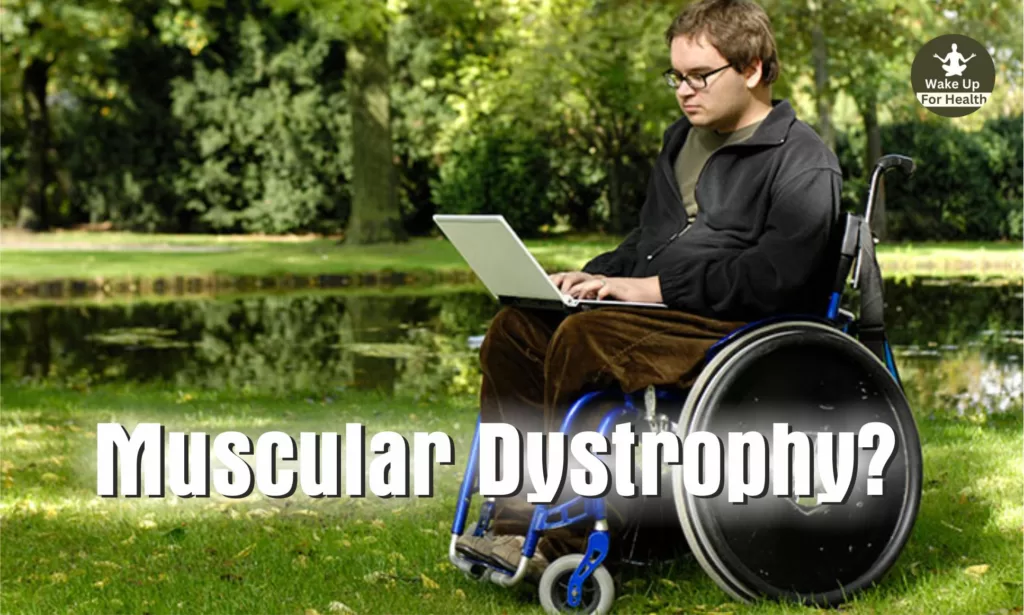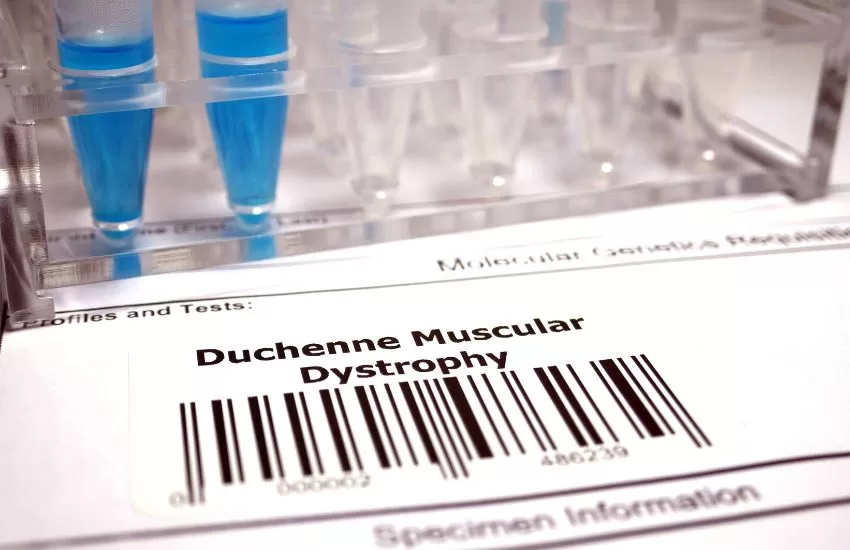- Muscle dystrophy is a serious non-infectious disease that affects the muscles, causing weakness and degeneration.
Muscle dystrophy, also known as muscular dystrophy, is a serious non-infectious disease that affects the muscles, causing weakness and degeneration. Muscle dystrophy or Muscular dystrophy lead to gradual muscle loss and weakening. The faulty genes (mutations) that cause muscular dystrophy prevent the body from producing the proteins required to develop healthy muscles.

Muscle dystrophy or Muscular dystrophy comes in various forms. Most often in boys, the most prevalent type’s symptoms start in early childhood. Other types don’t show up until later in life. The disease muscular dystrophy has no known cure. However, medications and treatments can aid in the management of symptoms and stop the spread of the illness.
Types of Muscular Dystrophy or Muscular Dystrophy Symptoms?,

Progression of muscle weakening is the main sign of muscular dystrophy. Depending on the kind of muscular dystrophy, particular signs and symptoms appear at various ages and in various muscle groups. Here below are all the possible symptoms depending on the type of Muscle dystrophy or Muscular dystrophy:
1. Duchenne Type Muscular Dystrophy
This is the most common form. Although girls can be carriers and mildly affected, it is more common in boys. The following signs and symptoms, which typically start in childhood:
- Frequent falls
- Difficulty rising from a sitting or lying down position
- Trouble running and jumping
- Wobbler
- Walking on toes
- Large muscles of the feet and calves
- Muscle pain and stiffness
- Learning Problems
- Delayed Growth
- Height Growth Problems
2. Becker Muscular Dystrophy
Though milder and progressing more slowly, it exhibits symptoms and signs that are comparable to those of Duchenne muscular dystrophy. Symptoms usually begin in adolescence but may not occur until the mid-20s or later.
Do you know : Duchenne Muscular Dystrophy Symptoms & Treatment
3. Oculopharyngeal Muscular Dystrophy (OPMD).
Oculopharyngeal muscular dystrophy (OPMD) causes weakness in the muscles of your face, neck, and shoulders. Other symptoms include:
- Fluttering Eyelids
- Eyesight problem
- Trouble swallowing
- Voice Change
- Heart problems
- Difficulty in walking
OPMD is one of the rarer types of muscular dystrophy, affecting less than 1 in 100,000 people in the United States. In their 40s or 50s, people typically start to exhibit symptoms.
4. Distal Muscular Dystrophy
Distal muscular dystrophy is also called distal myopathy. It is a group of more than six diseases that affect the muscles distal to the shoulders and hips, specifically:
Forearms, Hands, Calves, Feet.
5. Other Types of Muscle Dystrophy or Muscular Dystrophy
Some forms of muscular dystrophy are distinguished by a particular trait or by the location of the onset of the symptoms in the body. Examples include the following:-
5.1) Myotonic
It is characterized by the inability of the muscles to relax after contraction. Myotonia, which is the inability of your muscles to relax after contracting, is brought on by this type of muscular dystrophy. Steinert’s illness and dystrophia myotonica are other names for myotonic dystrophy. People with other types of muscular dystrophy do not experience myotonia, but it is a symptom of other muscle diseases. Symptoms include:
- Facial muscles
- Central Nervous System (CNS)
- Adrenal gland
- Heart
- Thyroid
- eyes
- Gastrointestinal tract
Symptoms first appear in the face and neck, they include:
- Dropping of muscles in the face, creating a thin, drawn-out look
- Difficulty lifting the neck due to weak neck muscles
- Difficulty swallowing
- Drooping eyelids, or ptosis
- Early baldness in the frontal area of the scalp
- Poor vision including cataracts
- Weight Loss
- Increased sweating
Additionally, this type of dystrophy may result in testicular atrophy and impotence. In others, it can cause irregular periods and infertility.
What is Age Macular Degeneration (AMD)?
Myotonic dystrophy is most likely to be diagnosed in adults in their 20s. The severity of symptoms can vary greatly. While some people only have minor symptoms, others may have heart- and lung-related symptoms that could be fatal. With the condition, many people live long lives.
5.2) Facioscapulohumeral (FSHD)
Muscle weakness usually begins in the face, hips, and shoulders. When the arms are raised, the shoulder blades can stick out like wings. Onset is usually in adolescence but can begin in childhood or as early as age 50.
5.3) Congenital
This type affects boys and girls and is evident at birth or before age 2. While some forms progress gradually and only slightly impair people, others advance quickly and seriously harm people.
Congenital muscular dystrophy is most often apparent between birth and 2 years of age. This is when parents begin to notice that their child’s motor function and muscle control are not developing as they should. Its symptoms vary and may include:-
- Muscle weakness
- Poor Motor Control
- Inability to sit or stand without support
- Scoliosis
- Foot deformities
- Trouble swallowing
- Respiratory problems
- Eyesight problem
- Speech Problems
- Learning Gaps
Symptoms range from mild to severe. The lifespan of a person with this type of muscle dystrophy or muscular dystrophy also varies depending on their symptoms. Congenital muscular dystrophy can cause infant death syndrome or adult life.
5.4) Limb-girdle
The muscles of the hip and shoulder are usually the first to be affected. People with this type of muscular dystrophy may have difficulty lifting the front part of the leg and may therefore trip frequently. Onset usually begins in childhood or adolescence.
What is the Cause of Muscle Dystrophy or Muscular Dystrophy?
Differences in genes cause muscular dystrophy. Thousands of genes are responsible for the proteins that determine the integrity of muscles. People carry genes on 23 pairs of chromosomes, with half of each pair inherited from the biological parent. One of these pairs of chromosomes is linked to sex.
This means that depending on your sex or the sex of your parents, the features or conditions you inherit as a result of those genes may vary. The other 22 pairs are not sex-linked and are also known as autosomal chromosomes.
Changes in a single gene can result in a lack of dystrophin, an important protein. The body may not make enough dystrophin, may not make it correctly, or may not make it at all. There are four ways that people can get muscular dystrophy. Muscle dystrophy or Muscular dystrophy is typically caused by inherited gene variations, however they can also result from a spontaneous mutation.
What are the Risk Factors for Muscular Dystrophy?
Muscle dystrophy or Muscular dystrophy is a genetic condition. Being a carrier or getting muscular dystrophy is more likely if your family has a history of the disease. Since DMD and BMD are linked to the X chromosome, children who are assigned male are more likely to experience them.

However, even though children assigned to children receive one X chromosome from each parent and should have sufficient dystrophin production, they may still experience symptoms of DMD or BMD, such as muscle spasms, weakness. and heart problems.
What are the Complications of Muscular Dystrophy?
Progressive Muscular weakening has the following side effects:
1. Difficulty Walking
Some muscular dystrophies patients eventually use a wheelchair.
2. Problems Utilising your Arms
When the hands and shoulders’ muscles are weakened, daily activities may become more challenging.
3. Shortening of the muscles or tendons around the joints (Contractures):
Contractures can further limit mobility.
4. Shortness of Breath
Progressive weakness may affect the muscles involved in breathing. People with muscular dystrophy may eventually need to use a breathing assistance device (ventilator), initially at night but possibly during the day as well.
5. Curved Pine (Pcoliosis)
Weak muscles may be unable to keep the spine straight.
6. Heart Problems
Muscular dystrophy can reduce the functionality of the heart muscles.
7. Swallowing Problems
If the muscles associated with swallowing are affected, nutritional problems and aspiration pneumonia may develop. Feeding tubes may be an option.
Does Pregnancy cause Problems with Muscular Dystrophy?
Given the difficulties and probable complications associated with pregnancy, people with muscular dystrophy may need to rethink their conception of the topic. Muscle weakness in the muscles of the legs, hips, and abdomen can make it difficult to push during labor, increasing the likelihood of cesarean delivery or other interventions.
Pregnancy loss can result from the generalised muscle weakness that might be caused by myotonic dystrophy. Pregnancy can also cause people with myotonic dystrophy to experience a rapid onset and worsening of their symptoms.
How is Muscular Dystrophy Diagnosed?

If you want want to know about muscular dystrophy diagnosis, then you should know that a medical history and physical examination will probably be the first steps taken by your doctor. After that, your doctor may recommend some of the following tests:-
1. Enzyme Tests
Damaged muscles release enzymes such as creatine kinase (CK) into your blood. In a person who has not suffered a traumatic injury, a high blood level of CK suggests muscle disease.
2. Genetic Testing
Blood samples can be tested for mutations in certain genes that cause the type of muscular dystrophy.
3. Muscle Biopsy
A small piece of muscle can be removed by making an incision or with a hollow needle. Analysis of tissue samples can differentiate muscular dystrophy from other muscle diseases.
4. Heart-Monitoring Tests (Electrocardiography and Echocardiogram)
These tests are used to check heart function, especially in people with myotonic muscular dystrophy.
5. Lung-Monitoring Tests
These tests are used to check the function of the lungs.
6. Electromyography
An electrode needle is inserted into the muscle for the test. As you unwind and gradually contract your muscles, the electrical activity is measured. Changes in the pattern of electrical activity can confirm muscle disease.
What is the Muscular Dystrophy Treatment?
Muscular dystrophy does not presently have a cure, however medicines can help you manage your symptoms and halt the disease’s progression. Treatments depend on your symptoms and the type of muscular dystrophy you have.
A. MEDICATIONS
For some DMD patients, new medicines have been approved by the Food and Drug Administration (FDA). Many of these treatments use a new process called “exon skipping,” where the faulty section (exon) of the dystrophin gene is patched so that the body can produce the protein.
These new drugs include:
1.Eteplirsen (Exondys 51) This weekly injection is for people with a specific mutation of the dystrophin gene that is responsible for skipping 51.
2.Golodirsen (Vyondys 53) This weekly injection is for people who have dystrophin gene difference, who can get away with skipping 53.
3.Viltolarsen (Viltepso) Viltolarsen (Viltepso) It is also a weekly injection for people with dystrophin gene difference which is skippable by 53 skipping.
4. Deflazacort (Emflaza) Deflazacort (Emflaza) It is a corticosteroid which is available in tablet and oral suspension form. It is approved for people ages 5 and older with DMD.
B. Muscle Therapy
Forms of muscle therapy have proven effective. Working with a professional is one of these methods for enhancing physical performance. Types of therapy include the following:-
- Physical Therapy, including physical activity and stretching, to keep muscles strong and flexible.
- Respiratory Therapy, to prevent or delay breathing problems.
- Speech Therapy, using specific techniques such as slow speech, pauses between breaths, and special equipment to preserve muscle strength.
Disclaimer : The article’s sole purpose is to wake you up for your health and to provide you the best collective and verified information. We do not recommend for any kind of medicine or treatment. You should only seek to your Doctor or Medical Counselor Because there is no one better than him.
F.A.Q.
Question : What is muscular dystrophy?
Answer : Muscular dystrophy (MD) refers to a group of more than 30 genetic diseases that cause progressive weakness and degeneration of skeletal muscles used during voluntary movement. These disorders vary in age of onset, severity, and pattern of affected muscles.
Question : What is the cause of muscular dystrophy?
Most cases of MD are caused by gene mutations (changes in the DNA sequence) that affect muscle proteins. The mutations are usually inherited, but in some cases they occur spontaneously. These spontaneous mutations can then be inherited by an affected person’s offspring.
Question : Is muscular dystrophy survivable?
Answer : Until recently, children with Duchenne muscular dystrophy (DMD) did not often live beyond their teens. However, improvements in cardiac and respiratory care mean that life expectancy is increasing, with many DMD patients reaching their 30s, and some living into their 40s and 50s.
Question : Is muscular dystrophy serious?
Answer : MD is a progressive condition, which means it gets worse over time. It often begins by affecting a particular group of muscles, before affecting the muscles more widely. Some types of MD eventually affect the heart or the muscles used for breathing, at which point the condition becomes life-threatening.
1 thought on “Muscle Dystrophy – Types, 5 Symptoms and Treatment”